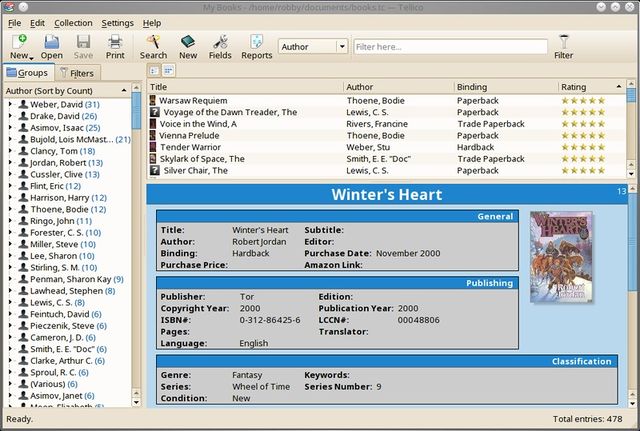Tellico/es: Difference between revisions
(Created page with "= Defectos =") |
(Created page with "[https://bugs.kde.org/buglist.cgi?query_format=specific&order=relevance+desc&bug_status=__all__&product=tellico Mostrar todos los informes de defecto de Tellico].") |
||
| Line 35: | Line 35: | ||
Bug reports for '''Tellico''' use [http://bugs.kde.org KDE's bugzilla]. | Bug reports for '''Tellico''' use [http://bugs.kde.org KDE's bugzilla]. | ||
[https://bugs.kde.org/buglist.cgi?query_format=specific&order=relevance+desc&bug_status=__all__&product=tellico | [https://bugs.kde.org/buglist.cgi?query_format=specific&order=relevance+desc&bug_status=__all__&product=tellico Mostrar todos los informes de defecto de Tellico]. | ||
Revision as of 08:05, 13 November 2019
| Tellico es una aplicación de catalogación que le facilita llevar un seguimiento de sus libros, vídeos, música… incluso sus vinos, o cualquier otra cosa. Su interfaz sencilla e intuitiva muestra imágenes de cubierta, agrupaciones y cualquier otro detalle importante para usted. Recupere información de numerosos sitios populares en Internet, incluidos IMDB.com, Amazon.com y muchas bibliotecas.
Tellico forma parte de KDE Extragear, en el módulo Oficina |
De un vistazo
La ventana principal de Tellico luce semejante a esta imagen:

Tellico puede hacer uso de diversas plantillas para modificar el formato de la información en la colección.
Obtener Tellico
Tellico está disponible en la mayoría de las distribuciones Linux, así como en el repositorio «ports» de las diversas variantes de BSD. Revise su gestor de paquetes para ver si existe un paquete.
En la página de descarga de Tellico se enumeran enlaces a muchos de los paquetes existentes.
Compilar Tellico a partir de su código fuente exige la instalación de varios paquetes de desarrollo.
Para Ubuntu/Kubuntu hay paquetes no oficiales en un PPA.
More Information
- The Tellico website is http://tellico-project.org
- The Tellico user documentation is also available online.
- Questions and comments can be sent to the tellico-users mailing list.
- You can also post a message in Tellico forum.
Defectos
Bug reports for Tellico use KDE's bugzilla.
Mostrar todos los informes de defecto de Tellico.
XSLT processing
Tellico use XSL files for templates, reports, import, processing data source and export. XSL files apply on XML data. The Tellico's DTD will give you the exact name of fields (because Tellico displays translated titles instead of names). Common places for this file are /usr/share/tellico/tellico.dtd or /usr/share/kde4/apps/tellico/tellico.dtd Beware that Tellico use libxslt1.1 which implement XPath 1.0 functions only. Fortunately, you can use EXSLT extensions.
Basical XSLT for transforming export
First, do an XML export. The file will serve as a reference for testing. Testing will be easier if you install an XSLT processor (xsltproc is available on every distribution). Then write an xsl stylesheet. Here's a basic one :
<?xml version="1.0" encoding="UTF-8"?> <xsl:stylesheet xmlns:xsl="http://www.w3.org/1999/XSL/Transform" xmlns:tc="http://periapsis.org/tellico/" version="1.0"> <xsl:output method="xml" version="1.0" encoding="UTF-8" indent="yes"/> <xsl:template match="/"> <xsl:apply-templates select="tc:tellico"/> </xsl:template> <xsl:template match="tc:tellico"> <xsl:apply-templates select="tc:collection"/> </xsl:template> <!-- about your collection --> <xsl:template match="tc:collection"> <books><!-- sample xml output --> <xsl:apply-templates select="tc:entry"/> <books> </xsl:template> <!-- transform each entry --> <xsl:template match="tc:entry"> <book><!-- sample xml output --> <title><xsl:value-of select="title"/></title> <!-- other fields --> </book> </xsl:template> </xsl:stylesheet>
Default fields in use for import
If you want to extend Tellico, you will certainly modify its XSLT processing files. To do this you will need the name of fields from the DTD, but current xsl files use several other names specific of collections and data sources. Using these default names for fields will makes your XSLT more compatible with others (for example "dewey" and "loc" are used for several data sources).
The list is built at Tellico/DefaultFields

